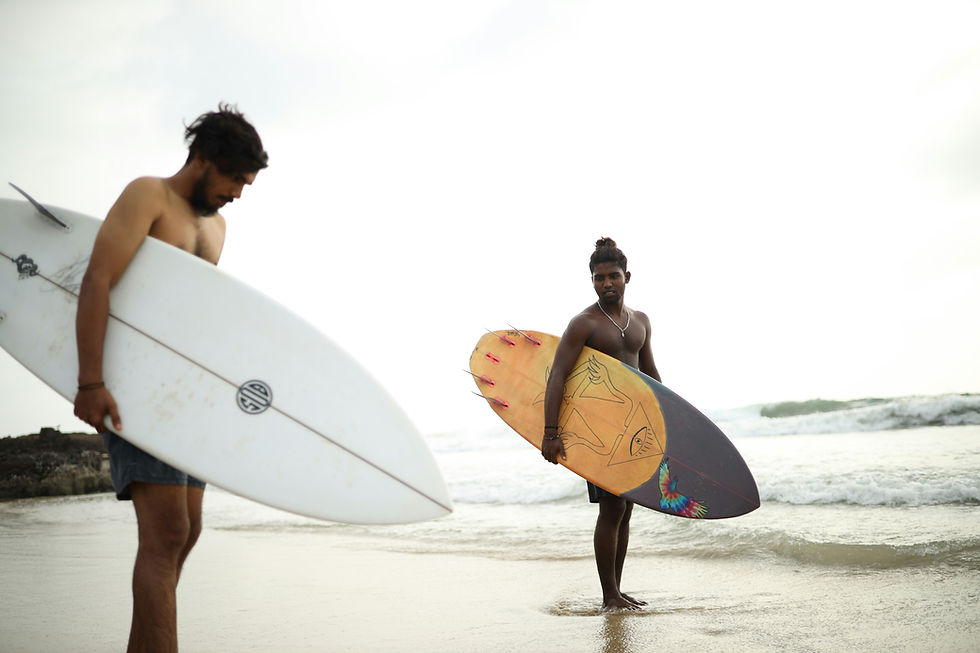The Surfer's Guide to Choosing the Right Surf Board
- Randall Head
- Sep 26, 2024
- 4 min read

Choose The Right Surf Board for Your Ability & Chosen Waves
Ready to shred but not sure which board to surf? Choosing the right board for your surfing level, as well as the specific conditions you’ll encounter, will help you catch more of these amazing waves. There are a lot of different boards out there, and each have their own strengths (as well as weaknesses). We put together a short guide to help you understand the differences between them so you can choose your next board with confidence!
The Soft-Top a.k.a. Foamie

Ubiquitous with beach breaks and surf camps around the world, the Soft-Top board (also affectionately called a Foamie) is your ticket into the world of surfing. These boards are usually 7-9 feet in length, very wide, and covered in a soft foam which keeps you and others around you safe in the event of a collision. Foamies provide a safe and stable platform for Level 1 surfers to practice popping up, paddling, and catching their first waves.
That's not to say Foamies are only enjoyed by beginners; sometimes it's good fun to take one out on lazy days, as it's quite easy to catch waves with one . . . they're just not the most nimble boards to maneouver! In recent years, some shapers have experimented with smaller, more performance-oriented Soft-Top shapes, which might be an appealing step-up board for some Level 1-2 surfers.
Mid-Length Boards

Forgotten until recently, it’s refreshing to see the surfing world revisit this wave catching machine. The Mid-Length board (sometimes referred to as Mini Mal or Fun Board) is typically 7’ to 8’6”, and often features flowing outlines with the widest point of the board a good bit forward from the centre point.
This style of board turns and flows in all sizes of surf, and will open up the world of correct technique while vastly increasing your wave count. Mid-Length boards can be magical for beginner and intermediate surfers! Whether your Mid-Length comes in a single-fin or 3-fin set up, the speed and flow will really level up your surfing.
The Regular Shortboard

This is the type of board you will see pro surfers and the like ride on steep, hollow, and powerful waves. Check out the pro models on the websites of today’s best board shapers and you’ll get the picture. These are great boards for sure, but think seriously about your own surfing level and fitness before paddling out on a Shortboard.
It’s important not to go for a board that’s beyond your ability and experience level. This is a common mistake that has held many surfers back in their development, especially if they didn’t grow up surfing or haven’t spent the necessary time progressing toward this level of performance surfboard.
Longboards and Logs

Longboarding has seen a renaissance in recent years, with many surfers around the world getting stoked on this stylish form of surfing. Nose riding, walking the board, and just steezing out - there's nothing like cruising on a Longboard or Log! There's an important distinction to make between these two types of boards though, and choosing a Longboard or a Log will result in a very different surf experience.
The modern Longboard is often seen with multiple fins and a rocker (the overall curve through the board) that allows it to be ridden on a huge variety of waves, including steep and powerful breaks.
The Log, however, is the classic, heavy, single-fin longboard that’s far more suited to gentle, rolling, and often longer waves. Taking a critical wave on a Log just isn’t fun, so if you’re a devoted Log rider, choose your spots carefully! Don’t forget that a Longboard is a wave-catching machine, so be sure to show the utmost respect to others in the water with you by giving them a few waves here and there.
Alternative Shortboards

Surfboard design is changing for the better all the time, and the range of what we can call Alternative Shortboards might be far more suited to your surfing experience, especially if you're a Level 2-3 surfer.
These boards are fun, user-friendly alternatives to the short board designs that the pros ride. With more volume and width, plus tons of maneuverability and paddle power, Alternative Shortboards seem to be the Holy Grail of late for shapers.
Most of us are far from pro standard surfers for sure, but if short boards are where you want to go at the moment, the selection of Alternative Shortboards available are well suited for waves all over the world.
Fish Boards

Along with the recent evolution of the Alternative Shortboard, there has also been a resurgence of the Fish design.
At its purest, this board style is short and wide with a good amount of volume, and it utilizes a twin-fin setup. Lighting-fast and super fun to ride, the Fish is a great design for a variety of surf spots.
Remember—not all boards are created equal, so be sure to choose a quality shaper, make, and model when picking up a Fish.
Ready to Get Surfing?
Choosing the right surfboard is essential for enhancing your surfing experience. From the forgiving foamie to the classic longboard and the maneuverable shortboard, there's a board out there to suit every surfer's style and ability level. By understanding the differences between different board types and considering your surfing goals, you can make an informed decision and ride the waves with confidence.



Comments